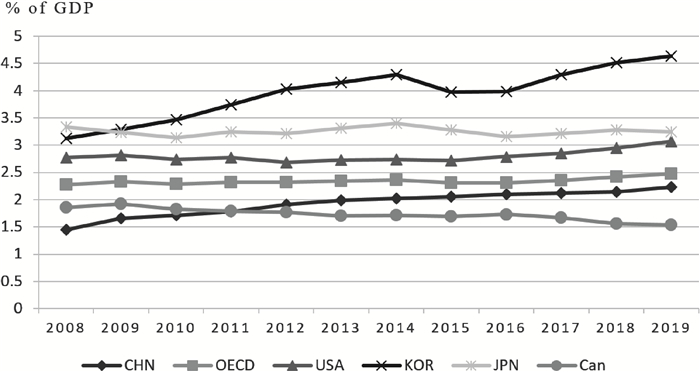Working Capital Management and the Persistence of Corporate R&D Innovation: A Review from the Perspective of Fictitious-toward Economy
-
摘要: 以2010—2019年中国A股非金融上市公司为研究样本,从内部平滑机制出发,实证考察营运资本管理与企业研发创新可持续性的关系,以及企业“脱实向虚”资产组合配置对营运资本管理平滑作用的影响。结果表明,在企业现金流大幅波动时,营运资本管理对企业研发创新具有平滑作用,而对固定资产投资的平滑效果并不突出。同时,企业金融资产配置主要发挥短期财富效应,弱化了营运资本管理对企业研发创新的平滑效果。分组检验发现,小规模企业和非国有企业的营运资本管理对研发创新的平滑作用更明显。进一步研究企业内部资产管理策略,发现在现金流剧烈波动时以积极的营运资本管理代替金融资产配置的企业的平均研发创新水平更高;企业的负债率及股权融资水平越低,其实施上述资产管理策略的概率越大。研究强调了“脱实向虚”背景下企业内部资产配置在维持企业研发创新可持续性中的不可或缺作用。Abstract: Starting from the internal smoothing mechanism, this pater takes China's A-share non-financial listed companies from 2010 to 2019 as the research sample, empirically examines the relationship between working capital management and the sustainability of corporate R&D innovation, and carefully investigates the impact of corporate financialized asset portfolio allocation on the smoothness of working capital management. The results show that when the cash flow fluctuates violently, working capital management can smooth their R&D innovation, but the smoothing effect on fixed asset investment is not significant; at the same time, the allocation of financial assets by companies mainly exerts short-term wealth effects, which weakens the smoothing effect of working capital management on corporate R&D innovation. Group tests found that the smoothing effect of working capital management on R&D innovation is more prominent in small-scale companies and non-state-owned companies. Furthermore, through the study on the internal asset management strategy of companies, it is also found that companies using active working capital management instead of allocating financial assets when cash flow fluctuates violently have a higher average level of R&D innovation; the lower the company's leverage and the level of equity financing, the more likely it is to implement active working capital management strategies. The conclusions emphasize the indispensable role of working capital management in maintaining the sustainability of R&D innovation under the fictitious-toward economy.
-
表 1 变量的统计性描述
变量 观测值 均值 标准差 最小值 中位数 最大值 R&D 11 000 17.538 7 1.228 6 13.730 7 17.549 2 20.600 2 WKS 11 000 0.046 0 1.358 8 -1.510 1 0.001 7 5.083 3 Fa 1100 0 0.264 1 0.159 7 0.024 9 0.228 6 0.796 0 ΔFa 10 000 -0.025 8 0.107 3 -0.719 6 -0.017 9 0.754 0 Size 11 000 21.650 4 0.950 7 19.886 3 21.564 1 24.511 8 Lev 11 000 0.452 0 0.258 7 0.046 8 0.417 8 0.983 5 Growth 11 000 0.001 9 0.003 5 -0.004 5 0.001 3 0.020 0 Stk 11 000 0.039 6 0.099 1 0.000 0 0.000 1 0.612 0 Cf 11 000 0.048 1 0.067 1 -0.203 0 0.045 7 0.250 7 表 2 基准回归
变量 因变量:R&D 因变量:Inv 因变量:R&D 因变量:R&D (1) (2) (3) (4) R&Dit-1 0.776 6*** 0.781 8*** 0.789 3*** (0.057 6) (0.045 6) (0.044 1) Invit-1 0.995 1*** (0.026 4) WKSi 0.005 2** 0.008 1 0.018 6*** (0.002 9) (0.005 1) (0.005 7) Fait-1 -0.331 7*** -0.308 8*** (0.089 6) (0.089 5) ΔFait 0.116 3* 0.101 9 (0.066 7) (0.066 7) W_Fit-1 -0.050 3*** (0.017 7) Levit-1 0.005 3 -0.131 3* -0.106 0* -0.088 7 (0.063 1) (0.069 7) (0.056 7) (0.055 7) Sizeit 0.216 6*** 0.058 4*** 0.220 4*** 0.212 8*** (0.047 8) (0.019 6) (0.038 9) (0.037 8) Growthit 29.296 1*** 9.996 7*** 32.975 4*** 33.342 3*** (3.489 1) (2.361 1) (3.487 6) (3.453 2) Stkit-1 0.114 3* -0.014 4 0.177 0*** 0.177 5*** (0.059 3) (0.070 2) (0.065 0) (0.065 3) Cons -0.849 0*** -1.041 2*** -0.892 8*** -0.868 0*** (0.222 4) (0.383 6) (0.213 4) (0.211 1) 行业效应 是 是 是 是 时间效应 是 是 是 是 AR(2) 0.185 0.201 0.164 0.159 Hansen 0.402 0.410 0.546 0.370 观测值 7 656 7 656 7 656 7 656 注:AR(2)检验和Hansen检验汇报对应p值;括号内为稳健标准误;*、**和***分别代表 10%、5%和1%的显著性水平。下表同。 表 3 替换性检验
变量 因变量:R&D 因变量:Inv 因变量:R&D 因变量:R&D (1) (2) (3) (4) R&Dt-1 0.772 6*** 0.784 7*** 0.770 7*** (0.044 0) (0.039 9) (0.043 8) Invt-1 0.971 5*** (0.029 6) Iwkt-1 -0.000 5** -0.000 2 -0.000 8*** (0.000 2) (0.000 2) (0.000 3) Fa1t-1 -0.863 6*** -0.843 9*** (0.170 4) (0.175 5) ΔFa1it 0.331 3** 0.320 3* (0.164 8) (0.167 7) W_F1it-1 0.007 8** (0.003 3) Sizeit 0.218 6*** 0.070 6*** 0.225 6*** 0.234 1*** (0.036 9) (0.021 5) (0.035 4) (0.038 3) Levit-1 -0.016 3 -0.156 2** -0.071 8 -0.045 7 (0.057 1) (0.070 3) (0.055 2) (0.056 1) Cfit-1 0.101 5 0.306 4* 0.130 7 0.125 1 (0.120 7) (0.157 6) (0.152 0) (0.155 8) Growthit 32.813 8*** 10.063 5*** 33.041 4*** 32.120 7*** (3.317 2) (2.345 8) (3.219 6) (3.367 2) Stkit-1 0.149 2** -0.030 0 0.132 8** 0.130 5** (0.062 3) (0.069 8) (0.061 4) (0.061 4) Cons -0.851 1*** -1.289 9*** -1.121 8*** -1.074 0*** (0.218 0) (0.420 4) (0.223 5) (0.226 5) 行业效应 是 是 是 是 时间效应 是 是 是 是 AR(2) 0.161 0.193 0.140 0.159 Hansen 0.200 0.141 0.465 0.171 观测值 7 656 5 896 7 656 7 656 表 4 渐进DID估计
变量 全样本 国有企业 非国有企业 大规模企业 中小规模企业 (1) (2) (3) (4) (5) St_WKSit 0.010 8** -0.064 4 0.012 4*** -0.093 7** 0.007 7*** (0.004 5) (0.045 1) (0.003 5) (0.043 5) (0.002 1) Levit-1 -0.006 1 0.315 3* -0.104 9 0.265 9** -0.134 0* (0.070 0) (0.183 0) (0.083 4) (0.105 8) (0.078 6) Sizeit 0.876 1*** 0.859 4*** 0.893 7*** 0.857 9*** 0.916 7*** (0.029 8) (0.053 4) (0.028 6) (0.058 8) (0.036 4) Growthit 6.252 0 18.462 0 2.955 4 1.948 0 6.406 9 (3.887 3) (11.166 8) (3.597 0) (6.005 4) (3.937 1) Stkit-1 -0.170 9* 0.207 9 -0.280 0*** -0.013 0 -0.261 5** (0.101 9) (0.294 0) (0.077 4) (0.202 3) (0.101 7) Cons -1.376 8** -1.471 0 -1.632 6** -1.234 2 -2.122 0*** (0.638 6) (1.164 4) (0.618 9) (1.305 5) (0.774 0) R2 0.553 2 0.630 8 0.552 9 0.532 6 0.479 0 观测值 7 652 1 650 5 999 2 544 5 102 表 5 营运资本存量的影响及其他可能解释
变量 营运资本存量的影响 (3)其他可能解释 (1)低营运资本存量组 (2)高营运资本存量组 R&Dit-1 0.787 5*** 0.838 6*** 0.785 1*** (0.057 3) (0.045 5) (0.045 2) WKSi -0.002 5 0.011 7** 0.004 5* (0.012 7) (0.005 2) (0.002 7) ΔCashit 0.029 5 (0.067 4) Cfit-1 0.106 6 (0.154 0) Levit-1 0.056 0 -0.061 9 -0.008 4 (0.069 1) (0.110 8) (0.055 2) Sizeit 0.199 5*** 0.192 2*** 0.207 7*** (0.047 7) (0.051 1) (0.038 2) Growthit 30.741 7*** 39.117 4*** 33.462 7*** (3.845 0) (6.617 4) (3.314 1) Stkit-1 0.161 1** 0.201 6 0.180 2*** (0.073 8) (0.125 8) (0.063 4) Cons -0.762 6*** -1.020 9* -0.803 6*** (0.242 3) (0.598 6) (0.222 0) 行业效应 是 是 是 时间效应 是 是 是 AR(2) 0.146 0.754 0.146 Hansen 0.273 0.973 0.217 观测值 6 271 1 385 7 656 表 6 异质性分析
变量 小规模企业 大规模企业 国有企业 非国有企业 (1) (2) (3) (4) R&Dit-1 0.809 0*** 0.749 4*** 0.771 2*** 0.786 2*** (0.051 0) (0.093 5) (0.064 6) (0.058 2) WKSi 0.017 9** -0.028 2 -0.017 2 0.004 7* (0.008 3) (0.021 8) (0.019 3) (0.002 5) Levit-1 -0.150 0* -0.010 7 0.137 8 -0.043 0 (0.087 9) (0.096 7) (0.161 0) (0.069 2) Sizeit 0.273 2*** 0.225 1*** 0.215 0*** 0.217 3*** (0.050 0) (0.079 5) (0.059 7) (0.048 2) Growthit 26.453 6*** 34.164 2*** 19.522 3** 33.805 5*** (3.863 3) (7.057 8) (9.692 8) (4.157 6) Stkit-1 0.064 4 0.113 8 0.256 7 0.176 3** (0.081 7) (0.105 0) (0.384 9) (0.068 9) Cons -2.274 9*** -1.150 3** -1.069 0** -0.872 4*** (0.439 2) (0.504 0) (0.543 6) (0.223 5) 行业效应 是 是 是 是 时间效应 是 是 是 是 AR(2) 0.644 0.768 0.215 0.471 Hansen 0.895 0.503 0.626 0.349 观测值 2 474 2 549 1 654 6 002 表 7 分组均值描述性统计
组别 R&D Lev Size Stk Cf Growth Inv HH组 17.370 6 0.466 8 21.531 5 0.041 7 0.045 9 0.001 8 2.282 0 HL组 17.747 9 0.427 6 21.783 7 0.032 2 0.054 5 0.001 8 2.409 9 LH组 17.430 5 0.454 5 21.563 3 0.044 1 0.048 0 0.002 0 2.373 9 LL组 17.743 6 0.450 8 21.826 1 0.037 0 0.045 3 0.001 8 2.710 1 表 8 以HL为因变量的logit回归结果
变量 全样本 HL组与LL组 HL组与LH组 HL组与HH组 (1) (2) (3) (4) Levit-1 -0.684 6*** -0.549 6*** -0.526 4*** -1.034 1*** (0.134 0) (0.168 1) (0.165 1) (0.169 5) Stkit-1 -1.632 8*** -1.026 8*** -1.790 5*** -2.048 8*** (0.310 2) (0.390 1) (0.357 3) (0.369 2) Controls 是 是 是 是 行业效应 是 是 是 是 时间效应 是 是 是 是 Pseudo-R2 0.054 7 0.038 8 0.093 6 0.101 5 观测值 7 656 3 323 3 766 3 749 -
[1] 刘贯春, 刘媛媛, 张军. 经济政策不确定性与中国上市公司的资产组合配置——兼论实体企业的"金融化"趋势[J]. 经济学(季刊), 2020(5): 65-86. https://www.cnki.com.cn/Article/CJFDTOTAL-JJXU202005005.htm [2] 张成思, 张步昙. 中国实业投资率下降之谜: 经济金融化视角[J]. 经济研究, 2016(12): 32-46. https://www.cnki.com.cn/Article/CJFDTOTAL-JJYJ201612004.htm [3] HALL B H. The financing of research and development[J]. Oxford Review of Economic Policy, 2002, 18(1): 35-51. doi: 10.1093/oxrep/18.1.35 [4] 林毅夫, 李永军. 中小金融机构发展与中小企业融资[J]. 经济研究, 2001(1): 10-18, 53-93. https://www.cnki.com.cn/Article/CJFDTOTAL-JJYJ200101001.htm [5] 刘畅, 刘冲, 马光荣. 中小金融机构与中小企业贷款[J]. 经济研究, 2017(8): 65-77. https://www.cnki.com.cn/Article/CJFDTOTAL-JJYJ201708006.htm [6] 朱武祥, 张平, 李鹏飞, 等. 疫情冲击下中小微企业困境与政策效率提升——基于两次全国问卷调查的分析[J]. 管理世界, 2020(4): 13-26. doi: 10.3969/j.issn.1002-5502.2020.04.004 [7] BROWN J R, PETERSEN B C. Cash holdings and R&D smoothing[J]. Journal of Corporate Finance, 2011, 17(3): 694-709. doi: 10.1016/j.jcorpfin.2010.01.003 [8] 吴淑娥, 仲伟周, 卫剑波, 等. 融资来源、现金持有与研发平滑——来自我国生物医药制造业的经验证据[J]. 经济学(季刊), 2016(1): 745-766. https://www.cnki.com.cn/Article/CJFDTOTAL-JJXU201602014.htm [9] 刘贯春, 刘媛媛, 张军. 金融资产配置与中国上市公司的投资波动[J]. 经济学(季刊), 2019(2): 573-596. https://wenku.baidu.com/view/046568957c21af45b307e87101f69e314232fa71 [10] 彭俞超, 黄志刚. 经济"脱实向虚"的成因与治理: 理解十九大金融体制改革[J]. 世界经济, 2018(9): 3-25. https://www.cnki.com.cn/Article/CJFDTOTAL-SJJJ201809002.htm [11] 李博阳, 沈悦, 张嘉望. 金融资产配置、企业经营风险与企业杠杆率[J]. 当代经济科学, 2019(5): 116-128. https://www.cnki.com.cn/Article/CJFDTOTAL-DJKX201905012.htm [12] 鞠晓生, 卢荻, 虞义华. 融资约束、营运资本管理与企业创新可持续性[J]. 经济研究, 2013(1): 4-16. https://www.cnki.com.cn/Article/CJFDTOTAL-JJYJ201301003.htm [13] DING S, GUARIGLIA A, KNIGHT J. Investment and financing constraints in China: does working capital management make a difference?[J]. Journal of Banking & Finance, 2013, 37(5): 1490-1507. https://www.sciencedirect.com/science/article/abs/pii/S0378426612000878 [14] HIMMELBERG C P, PETERSEN B C. R & D and internal finance: a panel study of small firms in high-tech industries[J]. The Review of Economics and Statistics, 1994, 76(1): 38-51. doi: 10.2307/2109824 [15] AKCIGIT U, LIU Q. The role of information in innovation and competition[J]. Journal of the European Economic Association, 2015, 14(4): 828-870. http://www.ufukakcigit.com/s/AKCIGIT_LIU.PDF [16] ALMEIDA H, CAMPELLO M, WEISBACH M S. The cash flow sensitivity of cash[J]. The Journal of Finance, 2004, 59(4): 1777-1804. doi: 10.1111/j.1540-6261.2004.00679.x [17] BROWN J R, MARTINSSON G, PETERSEN B C. Do financing constraints matter for R&D?[J]. European Economic Review, 2012, 56(8): 1512-1529. http://www.sciencedirect.com/science/article/pii/S0014292112001080 [18] KLIMAN A, WILLIAMS S D. Why 'financialisation' hasn't depressed US productive investment[J]. Cambridge Journal of Economics, 2015, 39(1): 67-92. https://academic.oup.com/cje/article-abstract/39/1/67/2875615?redirectedFrom=fulltext [19] 刘贯春. 金融资产配置与企业研发创新: "挤出"还是"挤入"[J]. 统计研究, 2017(7): 51-63. https://www.cnki.com.cn/Article/CJFDTOTAL-TJYJ201707005.htm [20] 段军山, 庄旭东. 金融投资行为与企业技术创新——动机分析与经验证据[J]. 中国工业经济, 2021(1): 155-173. https://www.cnki.com.cn/Article/CJFDTOTAL-GGYY202101010.htm [21] BONFIGLIOLI A. Financial integration, productivity and capital accumulation[J]. Journal of International Economics, 2008, 76(2): 337-355. http://www.iadb.org/intal/intalcdi/PE/2012/11126a04.pdf [22] 杨松令, 牛登云, 刘亭立, 等. 实体企业金融化、分析师关注与内部创新驱动力[J]. 管理科学, 2019(2): 3-18. https://www.cnki.com.cn/Article/CJFDTOTAL-JCJJ201902002.htm [23] SHLEIFER A, VISHNY R W. Liquidation values and debt capacity: a market equilibrium approach[J]. Journal of Finance, 1992, 47(4): 1343-1366. http://www.onacademic.com/detail/journal_1000039098808410_1969.html [24] 张嘉望, 李博阳. 资产可逆性、抵押品渠道与企业投资效率——基于融资约束异质性视角[J]. 经济管理, 2021(5): 159-176. https://www.cnki.com.cn/Article/CJFDTOTAL-JJGU202105010.htm [25] BERNSTEIN J I, NADIRI M I. Advances in econometrics and modelling[M]. Dordrecht: Springer, 1989. [26] CHIRINKO R S, FAZZARI S M. Economic fluctuations, market power, and returns to scale: evidence from firm-level data[J]. Journal of Applied Econometrics, 1994, 9(1): 47-69. http://ideas.repec.org/a/jae/japmet/v9y1994i1p47-69.html [27] HAMERMESH D S, PFANN G A. Adjustment costs in factor demand[J]. Journal of Economic Literature, 1996, 34(3): 1264-1292. http://ideas.repec.org/r/aea/jeclit/v34y1996i3p1264-1292.html [28] FAZZARI S M, PETERSEN B C. Working capital and fixed investment: new evidence on financing constraints[J]. The Rand Journal of Economics, 1993, 24(3): 328-342. [29] 徐晨阳. 资产专用性对营运资本平滑作用的影响研究——基于供应商集中度的视角[J]. 中国软科学, 2018(1): 183-192. https://www.cnki.com.cn/Article/CJFDTOTAL-ZGRK201801017.htm [30] 吴娜, 于博, 王博梓. 市场化进程、创新投资与营运资本的动态调整[J]. 会计研究, 2017(6): 82-88. https://www.cnki.com.cn/Article/CJFDTOTAL-KJYJ201706013.htm [31] 刘贯春, 张军, 刘媛媛. 金融资产配置、宏观经济环境与企业杠杆率[J]. 世界经济, 2018(1): 148-173. https://www.cnki.com.cn/Article/CJFDTOTAL-SJJJ201801008.htm [32] GULEN H, ION M. Policy uncertainty and corporate investment[J]. The Review of Financial Studies, 2016, 29(3): 523-564. http://rfs.oxfordjournals.org/content/29/3.toc.pdf [33] 彭俞超, 倪骁然, 沈吉. 企业"脱实向虚"与金融市场稳定——基于股价崩盘风险的视角[J]. 经济研究, 2018(10): 50-66. https://www.cnki.com.cn/Article/CJFDTOTAL-JJYJ201810005.htm [34] SEN S, DASGUPTA Z. Financialisation and corporate investments: the Indian case[J]. Review of Keynesian Economics, 2018, 6(1): 96-113. http://www.econstor.eu/bitstream/10419/110007/1/815587686.pdf [35] EBERLY J, REBELO S, VINCENT N. What explains the lagged-investment effect?[J]. Journal of Monetary Economics, 2012, 59(4): 370-380. https://www.sciencedirect.com/science/article/abs/pii/S0304393212000529 [36] 刘贯春, 刘媛媛, 张军. 金融资产配置与中国上市公司的投资波动[J]. 经济学(季刊), 2019(2): 573-596. https://www.cnki.com.cn/Article/CJFDTOTAL-JJXU201902008.htm [37] 孔东民, 徐茗丽, 孔高文. 企业内部薪酬差距与创新[J]. 经济研究, 2017(10): 144-157. https://www.cnki.com.cn/Article/CJFDTOTAL-JJYJ201710011.htm [38] 谢家智, 王文涛, 江源. 制造业金融化、政府控制与技术创新[J]. 经济学动态, 2014(11): 78-88. https://www.cnki.com.cn/Article/CJFDTOTAL-JJXD201411011.htm [39] 张明. 中国影子银行: 界定、成因、风险与对策[J]. 国际经济评论, 2013(3): 82-92, 6. https://www.cnki.com.cn/Article/CJFDTOTAL-GJPP201303006.htm [40] 连玉君, 常亮, 苏治. 供需不确定性、市场竞争与现金持有——来自中国上市公司的经验证据[J]. 南方经济, 2009(1): 11-22. https://www.cnki.com.cn/Article/CJFDTOTAL-NFJJ200901005.htm [41] 彭俞超, 韩珣, 李建军. 经济政策不确定性与企业金融化[J]. 中国工业经济, 2018(1): 137-155. https://www.cnki.com.cn/Article/CJFDTOTAL-GGYY201801009.htm [42] FAZZARI S M, HUBBARD R G, PETERSEN B C, et al. Financing constraints and corporate investment[J]. Brookings Papers on Economic Activity, 1988(1): 141-206. http://www.nuffield.ox.ac.uk/media/2189/financing-constraints.pdf -





 下载:
下载:

